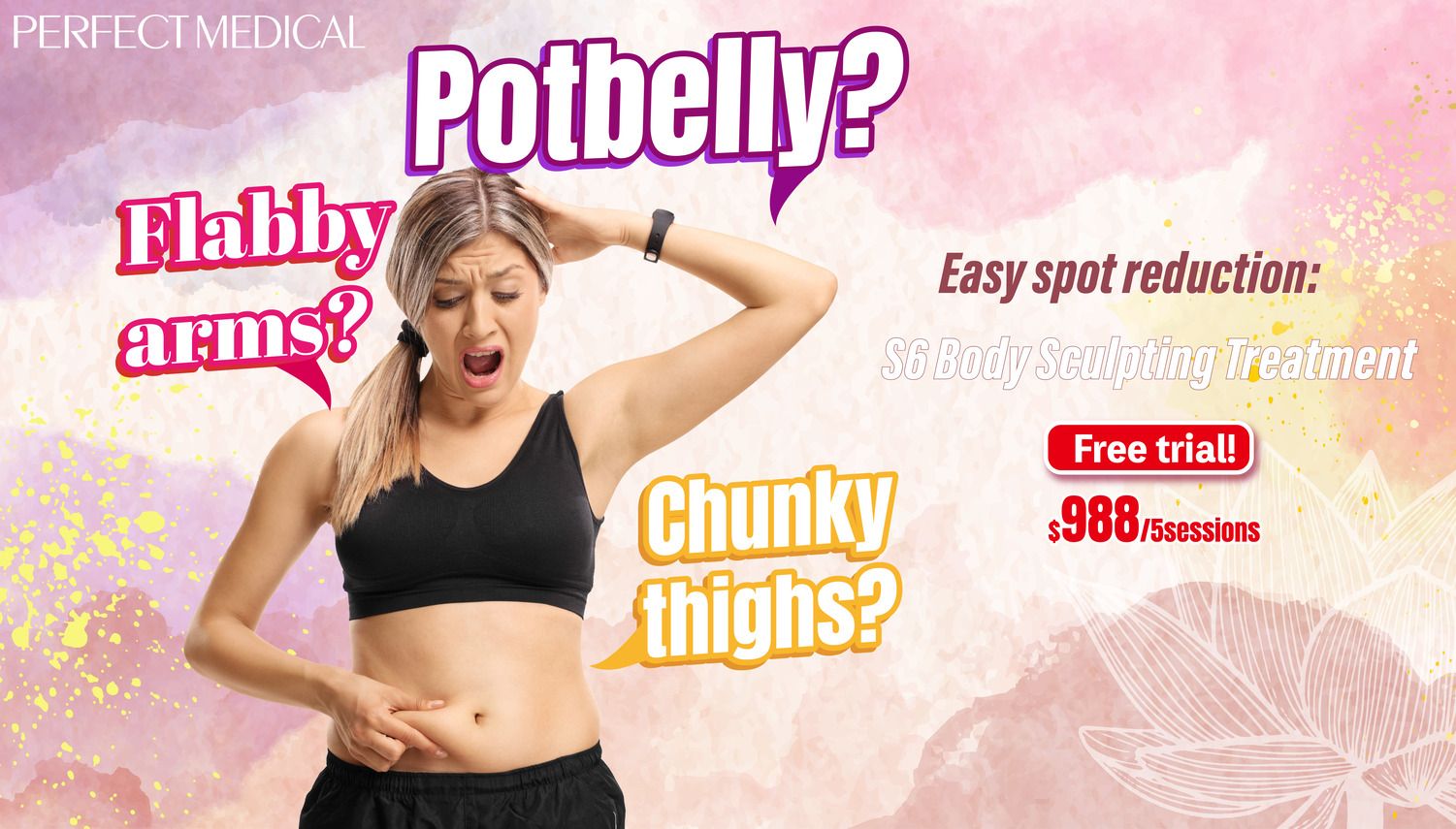- Home
- Trend
- Weight Loss Strategies
- Acne Tips
- Hair Health Information
- Blemish Removal Tips
- Acne Scar Removal Tips
- Muscle Building Techniques
- Intimate Care Tips
- Postpartum Intimate Care
- Eye Bags Wiki
- Tips for Face Slimming
- Secret of Permanent Hair Removal
- Breast Enlargement Tips
- Cure to Snoring
- Marionette Lines
- Skin-Tightening Secrets

免費體驗
S6 Body Sculpting Treatment
1 Minute Self-Registration
Date should not be before minimal date
Belly fat, also known as visceral fat, is more than just a cosmetic concern; it poses significant health risks. Excess fat around the abdomen is associated with various health issues, including heart disease, diabetes, and high blood pressure. Unfortunately, belly fat tends to be stubborn and challenging to lose. However, armed with knowledge and the right approach, you can tackle the battle of the bulge and achieve a healthier, trimmer waistline. In this article, we will delve into the science of belly fat, its implications, and the most effective strategies to banish it for good.
1
Understanding Belly Fat: Subcutaneous vs. Visceral Fat

Understanding the distinction between subcutaneous and visceral fat is crucial for managing overall health and well-being, particularly when it comes to belly fat.
Subcutaneous fat
Subcutaneous fat is the fat that lies just beneath the skin's surface and is visible as the "pinchable" layer of fat on various parts of the body, including the belly. It is the fat that you can feel and grab with your fingers. Subcutaneous fat serves several essential functions, such as providing insulation and cushioning for the body. While having excess subcutaneous fat may be aesthetically undesirable for some people, it is generally considered less harmful to health compared to visceral fat. Subcutaneous fat accumulation alone is not typically associated with a significantly increased risk of chronic health conditions.
Examples: When you pinch the skin on your abdomen and feel the soft layer of fat, that's subcutaneous fat. Similarly, when you can "pinch an inch" of fat on your thighs or arms, it's also subcutaneous fat.
Visceral fat
Visceral fat, in contrast, is located deep within the abdominal cavity, surrounding vital organs such as the liver, pancreas, and intestines. This type of fat is not visible from the outside and is often referred to as "belly fat." Unlike subcutaneous fat, too much visceral fat is linked to an increased risk of serious health conditions, including heart disease, type 2 diabetes, hypertension, and certain cancers. Visceral fat is metabolically active and can release hormones and other substances that contribute to inflammation and insulin resistance, both of which are risk factors for chronic diseases.
Examples: Visceral fat cannot be seen or easily measured without medical imaging techniques like CT scans or MRIs. However, its presence is associated with an increased waist circumference or waist-to-hip ratio, suggesting a higher concentration of fat deep within the abdominal area.
It's essential to maintain a healthy balance of body fat and focus on reducing visceral fat levels. Lifestyle factors such as regular physical activity, a balanced diet, and stress management can help in reducing overall body fat and particularly the harmful visceral fat. While some amount of subcutaneous fat is normal and even necessary for bodily functions, keeping visceral fat in check is crucial for promoting long-term health and reducing the risk of obesity-related diseases. Regular exercise, a healthy diet, and lifestyle modifications can play a significant role in achieving and maintaining a healthy fat distribution and overall well-being.
2
The Health Implications of Belly Fat

Carrying excess belly fat can have significant health implications beyond just being a matter of appearance. Here are some of the health risks associated with excessive belly fat:
1. Increased risk of heart disease
Excess belly fat, particularly visceral fat, is metabolically active and releases inflammatory substances into the bloodstream. These substances can contribute to the development of atherosclerosis, a condition where fatty deposits build up in the arteries, narrowing them and increasing the risk of heart disease. Additionally, belly fat is associated with unfavourable changes in cholesterol levels, including higher levels of LDL cholesterol (often referred to as "bad" cholesterol) and lower levels of HDL cholesterol ("good" cholesterol"). This imbalance further raises the risk of heart disease and other cardiovascular issues.
2. Insulin resistance and diabetes
Belly fat is closely linked to insulin resistance, a condition in which cells become less responsive to the effects of insulin, a hormone that helps regulate blood sugar levels. Insulin resistance leads to higher blood sugar levels, and over time, it can progress to type 2 diabetes. Individuals with excess belly fat are at a higher risk of developing type 2 diabetes compared to those with fat distributed in other areas of the body.
3. High blood pressure
Excess belly fat is associated with an increased risk of hypertension or high blood pressure. Visceral fat can promote the release of hormones and substances that contribute to blood vessel constriction and elevated blood pressure. Chronic high blood pressure can strain the cardiovascular system, increasing the risk of heart disease, stroke, and other related conditions.
4. Fatty liver disease
Visceral fat accumulation is closely linked to the development of non-alcoholic fatty liver disease (NAFLD). NAFLD occurs when fat accumulates in the liver, leading to inflammation and impaired liver function. If left untreated, NAFLD can progress to more severe liver conditions, such as non-alcoholic steatohepatitis (NASH) and cirrhosis. Excessive belly fat is considered a significant risk factor for the development and progression of fatty liver disease.
5. Increased risk of certain cancers
Some research suggests that excess belly fat may be associated with an increased risk of certain types of cancers, including breast cancer, colorectal cancer, and pancreatic cancer. The mechanisms linking belly fat to cancer risk are not entirely understood but may involve hormonal and inflammatory factors released by visceral fat.
It's essential to recognize that not all fat in the body is the same, and the location of fat storage matters for health. While some degree of body fat is necessary for energy storage and insulation, excess belly fat, especially visceral fat, poses a more significant risk to health compared to fat stored in other areas of the body.
Maintaining a healthy weight through a balanced diet, regular physical activity, and lifestyle modifications can help reduce belly fat and lower the risk of associated health conditions. Consulting with a healthcare professional or a registered dietitian can provide personalised guidance and support in managing belly fat and improving overall health.
3
What Can I Do to Reduce Belly Fat?

Combating belly fat and achieving a healthier waistline requires a holistic approach that combines healthy eating habits, regular physical activity, and lifestyle modifications. Here are some effective strategies to help you trim your waistline and improve overall health:
Healthy diet
Adopt a balanced and nutritious diet that includes a variety of foods from different food groups. Focus on incorporating plenty of fruits, vegetables, whole grains, lean proteins (such as poultry, fish, legumes, and tofu), and healthy fats (like avocados, nuts, and olive oil) into your meals. These nutrient-dense foods provide essential vitamins, minerals, and antioxidants while keeping you full and satisfied. Limit the consumption of sugary beverages, processed foods, and foods high in saturated and trans fats, as they contribute to weight gain and unhealthy belly fat accumulation.
Portion control
Pay attention to portion sizes during meals to avoid overeating. Use smaller plates and bowls to help control portion sizes and prevent the temptation to indulge in larger servings. Remember that it takes time for your body to signal fullness, so eat slowly and mindfully to avoid overeating.
Regular exercise
Engage in a combination of cardiovascular exercises and strength training to burn calories, build lean muscle mass, and boost metabolism. Cardio exercises, such as brisk walking, running, cycling, swimming, or dancing, help burn calories and reduce overall body fat, including belly fat. Incorporate strength training exercises, like weightlifting or bodyweight exercises, to build muscle, which can increase your resting metabolic rate and promote fat loss.
Hydration
Stay adequately hydrated by drinking plenty of water throughout the day. Water not only supports proper bodily functions but also helps with appetite regulation and can aid in reducing calorie intake. Drinking water before meals can help you feel fuller and prevent overeating.
Stress management
High levels of stress can lead to increased cortisol production, a hormone associated with abdominal fat accumulation. Practice stress-reducing techniques such as meditation, deep breathing exercises, yoga, or spending time in nature. Engaging in activities you enjoy and connecting with loved ones can also help alleviate stress.
Adequate sleep
Aim for 7-9 hours of quality sleep per night. Poor sleep habits can disrupt hormonal balance, leading to increased hunger and cravings, and may contribute to weight gain, including belly fat. Prioritise good sleep hygiene by establishing a consistent sleep schedule, creating a comfortable sleep environment, and limiting screen time before bedtime.
Remember that achieving a healthier waistline and managing belly fat is a gradual process that requires consistency and commitment. Make sustainable lifestyle changes that you can maintain in the long term, and consider seeking guidance from a healthcare professional or a registered dietitian to create a personalised plan tailored to your specific needs and goals. With a balanced approach to diet, regular physical activity, and overall well-being, you can effectively combat belly fat and improve your overall health and quality of life.
4
Spot Reduction: Myth or Reality?

One common misconception is the idea of spot reduction, which suggests that targeting specific exercises on a particular body part can eliminate fat in that area. Unfortunately, spot reduction is a myth. While targeted exercises can strengthen muscles, they do not specifically reduce fat in that area. To lose belly fat, focus on overall weight loss through a combination of diet and exercise.
However, there is an effective and non-surgical body contouring therapy called the S6 Body Sculpting Treatment that offers a potential solution for those seeking to shape specific body areas. Unlike spot reduction, the S6 Body Sculpting Treatment utilises a low-energy bio-laser to dissolve adipose layers and help you attain your ideal body outline.
The S6 Body Sculpting Treatment employs a patent-protected, low-energy bio-laser that penetrates deeply into the subcutaneous adipose layers of targeted body parts. By thermally destroying the fat cells and releasing fatty acids into the lymphatic system, this therapy facilitates the removal of stored fat. The treatment also includes a hoover suction technology that massages the treatment area, enhancing the metabolic rate in the process. Furthermore, the bio-laser technology stimulates collagen production, which not only tightens the skin but also contributes to a more toned appearance.
One of the significant advantages of the S6 Body Sculpting Treatment is its ability to target seven challenging-to-reduce-fat body areas, including the abdomen, waist, biceps, buttocks, thighs, and calves. By effectively addressing these areas, you can achieve a more sculpted and toned physique!

免費體驗
S6 Body Sculpting Treatment
1 Minute Self-Registration
Date should not be before minimal date
5
Conclusion

Combining the benefits of weight loss-friendly foods with the S6 Body Sculpting Treatment can accelerate your journey towards healthy weight loss and achieving your desired body shape. While spot reduction remains a myth, this non-invasive treatment offers a promising solution for individuals seeking to enhance specific body areas and achieve a more streamlined appearance. If you are looking to contour and reshape your body without surgery, the S6 Body Sculpting Treatment may be the answer you've been searching for. Consult with a qualified professional to determine if this treatment aligns with your goals and needs, and embark on the path to a more confident and healthier you.

免費體驗
S6 Body Sculpting Treatment
1 Minute Self-Registration
Date should not be before minimal date
FAQ

1. Can specific foods help reduce belly fat?
While no specific food can target belly fat, a balanced and nutritious diet can support overall weight loss, including fat around the abdomen. Incorporating a variety of nutrient-dense foods, such as fruits, vegetables, whole grains, lean proteins, and healthy fats, can help create a calorie deficit and promote fat loss throughout the body, including the belly area. Additionally, foods rich in fibre and protein can increase satiety and help control hunger, making it easier to manage calorie intake and support your weight loss goals. Remember that spot reduction is not possible, and sustainable weight loss requires a comprehensive approach, including a healthy diet and regular physical activity.
2. Are there any specific exercises to target belly fat?
While core-strengthening exercises can tone abdominal muscles, they do not eliminate belly fat. A combination of cardio and strength training is essential for overall fat loss. Cardiovascular exercises, such as running, cycling, swimming, or dancing, help burn calories and reduce body fat, including fat stored in the abdominal area. Strength training exercises, like planks, crunches, or leg raises, can strengthen and tone the abdominal muscles, enhancing their appearance once the fat layer above them decreases. However, it's important to understand that spot reduction is not effective in reducing fat in specific areas. To achieve significant and lasting fat loss in the belly region, a comprehensive workout routine that includes both cardio and strength training is necessary.
3. How long does it take to lose belly fat?
The time it takes to lose belly fat varies depending on individual factors such as diet, exercise routine, metabolism, and overall body composition. While some people may notice changes within a few weeks of adopting a healthy lifestyle, others may take longer to see visible results. It's crucial to approach belly fat reduction with realistic expectations and recognize that losing fat takes time and consistency. Sustainable weight loss involves making lasting lifestyle changes rather than seeking quick fixes. Gradual and steady progress is more likely to lead to long-term success. Be patient, stay dedicated to your health and fitness goals, and celebrate each milestone achieved along the way.
4. Can too much belly fat be a sign of an underlying health issue?
In some cases, excessive belly fat can be a sign of an underlying health issue, such as hormonal imbalances or insulin resistance. Visceral fat, the fat that accumulates deep within the abdominal cavity, is particularly concerning as it is associated with an increased risk of cardiovascular diseases and metabolic disorders. If you are concerned about your belly fat or if you have difficulty losing weight despite adopting a healthy lifestyle, it's best to consult a healthcare professional for a proper evaluation. They can assess your overall health, conduct relevant tests, and provide personalised recommendations to address any potential underlying health issues and guide you towards a healthier and fitter lifestyle.
5. How does aerobic exercise contribute to reducing belly fat?
Aerobic exercise plays a significant role in reducing belly fat and overall body fat. Also known as cardiovascular exercise, aerobic activities, such as running, cycling, swimming, and dancing, increase heart rate and respiration, leading to calorie expenditure. Engaging in regular aerobic exercise helps create a calorie deficit, where you burn more calories than you consume, leading to fat loss, including fat stored in the abdominal area. Additionally, aerobic exercise improves insulin sensitivity, which can help with better blood sugar regulation and potentially reduce fat accumulation around the belly. Combining aerobic exercise with a healthy diet and strength training can optimise fat loss and promote a leaner and healthier body composition.








